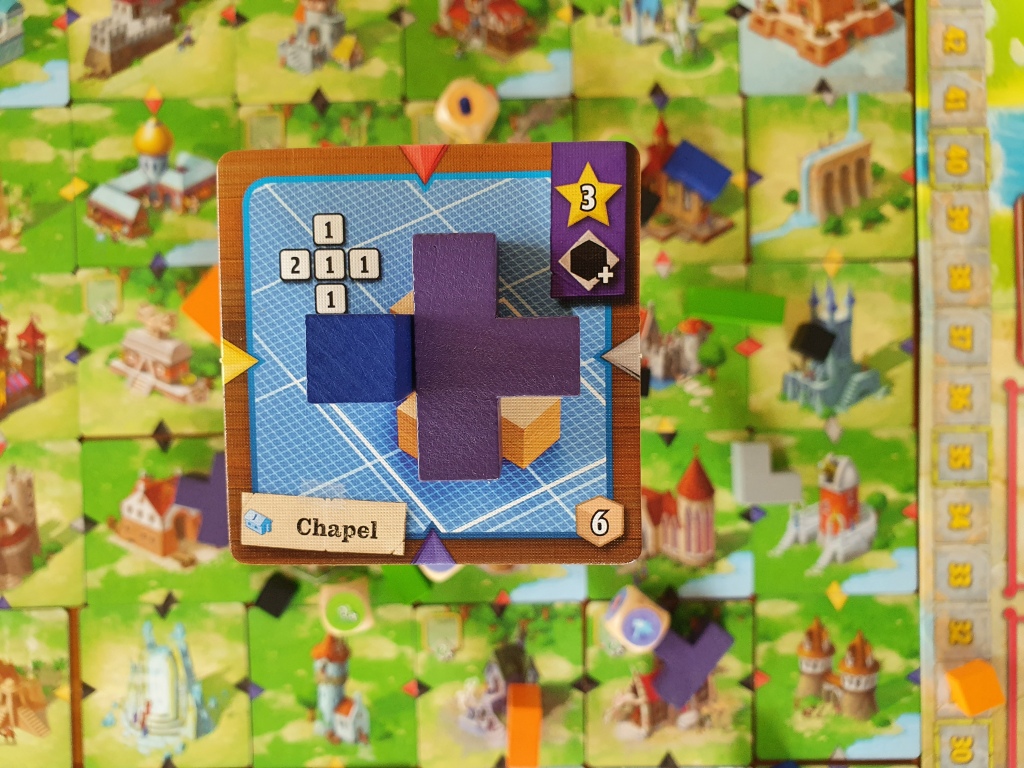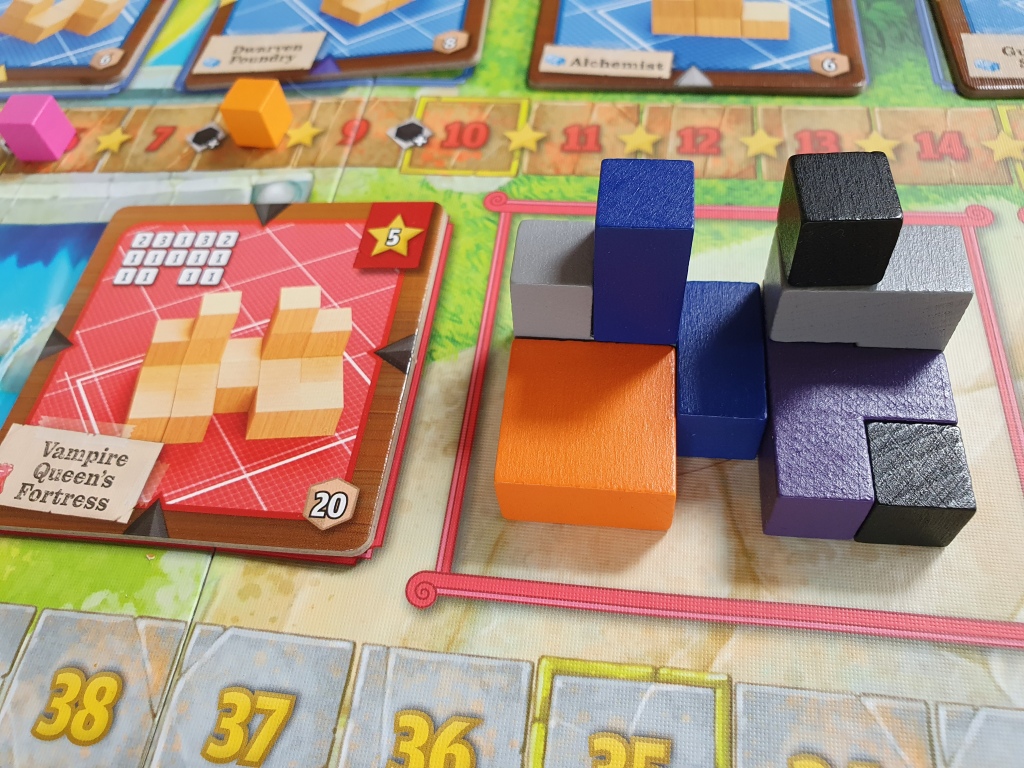
Review: Catacombs Cubes - by @svsjboardgames
Share


Quarry the resources needed to construct the village of Stormtryne and take the glory!
Set in the world of Catacombs, this game sees players competing to build the village of Stormtryne from resources drafted from the nearby quarry. Players physically use Tetris-like 3D shapes to construct buildings that add to the village, scoring points along the way. Central to the new village are two palaces that players build together. Who will contribute the most and become the winner?
How the game works
The aim of the game is to score the most points, which are primarily scored from constructing village buildings using 3D resources according to the blueprints on the village tiles.

Catacombs Cubes is played over a series of rounds where players take one of two actions:
- Draft resources from the quarry – each round there are several pairs of dice which are available for players to draft. They contain resources or coin tokens (which can be used for special abilities) which the players take and add to their construction yard. There are six different resources of various sizes as small as 1×1 (obsidian).
- Build a structure – using the resources in your construction yard or warehouse. There are always 4 tiles on display for players to build. Once you build it with your resources, discard them all back to the supply along with every other resource in your construction yard except for the 1×1 obsidian cubes. This is such an important rule to remember because it means you can’t just hoard resources and then build everything at once!

You can also spend as many of your earned coins on your turn, but a little more on that later!
When you construct a building you place it into the village, adjacent to another building and within a 4×4 grid. Each building tile has a coloured bonus triangle on each of its four edges, and you gain benefits depending on the colours and whether or not they match. Getting matching triangles can give you the edge you need- or present your opponents with an opportunity!

The coins you earn come in various colours. Blue coins allow you to “chisel” your resources into smaller pieces that help you get what you need to finish your buildings. Grey coins allow you to move a resource from your construction yard to your warehouse – which means it won’t be discarded once you build (as long as it isn’t used in the building). Red coins allow you to contribute to the palace using one of your resources.
There are two palaces in each game, which are bigger constructions built by all players over the course of the game. Each time a player contributes a tile to the palace they move their token along the palace track as many spaces as cubes they placed. Doing so will grant bonus points and 1×1 obsidian cubes, so it’s well worth building the palaces. The player who puts the final piece and finishes the palace gains the VP indicated on the tiles, be careful not to let your opponents steal the points!

The game ends once the village is 4×4 in size (2-3 player game) and 4×5 (4 player game). Bonuses are awarded for whoever has the most of each type of coin token, but primarily points will have come from the constructions during the game.

Review
Catacombs Cubes is in essence a family-weight game, which has great table presence due to the blocks and the building element of the game. It’s a cool concept- drafting dice from the quarry to build the village using the different shaped blocks. It’s a puzzle that will certainly work well as a gateway game but that may not stretch the more experienced gamer.
I’d expect anyone to enjoy the tactile nature of the game, it is quite satisfying putting all the pieces together in your construction yard, trying to figure out a way of building a tower/palace/village. Also the efficiency of not wanting to waste any tiles causes some interesting choices to be made. You might be about to waste a resource, so you could decide to contribute towards the palace instead- but what if someone else builds what you were planning to build in the meantime?!
The rules are fairly simple to teach as well so it is a good one to introduce to people. I would say the first learn/playthrough can be a little slow as there is a fair bit of set up (you need to physically put stickers on each face of 8 dice), but once one player knows what they’re doing it’s an easy game to teach/learn.

Something we really loved was the fact that in addition to constructing entire buildings for the village yourself, all players contribute to the building of the palace – it’s a really neat aspect of the game. You need to balance the pros of placing tiles there (you get one-off benefits for doing so) with the cons (you could contribute 19 out of 20 blocks to the construction and then be beaten to the VP reward by an opponent finishing it, and you are using precious resources to do so). We really enjoyed this dilemma and it turned out that the building of the palaces was the difference in each game we played. Plus they look really cool on the table as they’re being built.
The rounds felt a little slow at 2 players as you feel like you’re constantly resetting the dice, but works much better with 3 and 4 players. There won’t be much downtime as you’re either drafting dice or building but that doesn’t mean there’s too much of a limit on your options!
The village-building is very cool because you need to think about where you place your buildings – balance the benefit you gain from placing it adjacent to other buildings with the opportunities you are giving your opponents. Extra points, coin tokens, obsidian cubes might be exactly what the other players need to grab the win.

Final Thoughts
The clever clogs who made Catacombs Cubes created a few little variants to try which I won’t dwell too much on, but add a nice amount of replayability and options for players who prefer a little more, (or a little less) “take-that”. There’s also the option to use tiles instead of dice for the drafting of resources which adds another layer of complexity for those that need it. I’ve not tried the solo mode included, but I am a big fan of games that put the effort in to create a solo game.
Overall while we weren’t wowed by the game considering the super-cool concept of building with physical pieces, we still had a great time playing it and I know lots of people will absolutely love it. We’d especially recommend Catacomb Cubes to family gamers and newer games as we think it makes a fantastic gateway game. Its table presence and eye-catching box/card art will draw anyone in and the simple gameplay will make sure everyone is able to enjoy it.



